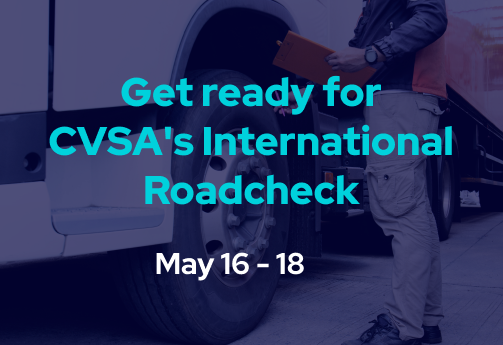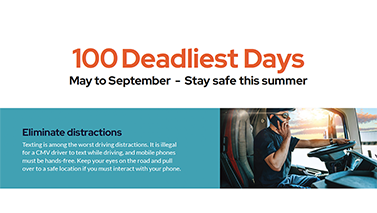Get ready for CVSA’s 2023 International Roadcheck

The Commercial Vehicle Safety Alliance (CVSA) International Roadcheck is an annual inspection event that takes place across North America to ensure commercial vehicles and their drivers comply with safety regulations. During the 2022 International Roadcheck, inspectors placed 8,718 vehicles out of service, which is a 23.1% vehicle out-of-service (OOS) rate. While the emphasis of last year’s road check was on wheel ends, false logs, wrong class license, brake systems, and tires were some of the most common OOS violations.
This year’s event is scheduled for May 16-18, and will particularly emphasize the importance of proper Anti-lock Braking Systems (ABS) and cargo securement, but drivers and carriers should still anticipate inspections in all other areas as well.
Here are some tips on how to prepare for the CVSA International Roadcheck:
- Refresh your knowledge of the Federal Motor Carrier Safety Regulations (FMCSRs): Brake related regulations can be found under Title 49 of the Code of Federal Regulations (CFR), Part 393 Subpart C and cargo securement under Part 393 Subpart I.
- Conduct a thorough pre-trip inspection: Before hitting the road, make sure to perform a thorough pre-trip inspection of your vehicle. Check the brakes, tires, lights, and other essential components to ensure they are in good working condition.
- Pay special attention to your load securement. Inspect for cut, frayed or worn straps or damaged ratchets, block and brace all Hazmat as required, and ensure the cargo doesn’t exceed the vehicles weight limit. All load securement devices must be marked with their load capacity or they can be downgraded to a minimum rating resulting in a violation.
- Synthetic webbing “straps” can not have more than 1/4 of the total stitched area separated. This is a combination of all damage. A 1/2″ tear on one side and a 1/2″ inch tear on the other side of the strap would be 1″ putting this strap out of service. Web separations in the center count as well. Tie-downs can not have knots or repairs and tensioning devices can not be damaged to the point of bending.
- Check that your ABS system is in proper working order. Drivers should pay particular attention to the ABS lights, worn or damaged ABS wheel speed sensor cables on the axles, brake lining and drum condition, air leaks, proper brake adjustment, and check for broken springs in brake chambers.
- Chains can not have bent, worn, or twisted links. Chains may not be worn more than 20% of their original thickness.
- Review your paperwork: Ensure that all your paperwork is up-to-date and readily accessible. This includes your CDL, registration, insurance, BOL’s and any necessary permits.
- Train your drivers: Make sure that your drivers are well-informed about the inspection requirements and are trained to handle any potential violations. Provide them with the necessary resources and support to ensure they feel confident and prepared.
- Stay up-to-date with regulations: Keep yourself informed about the latest safety regulations and requirements. Attend training sessions and seminars to stay abreast of any changes or updates.
- Maintain a culture of safety: Ultimately, safety should be a top priority for all drivers and fleet managers. Foster a culture of safety within your organization, and make sure that all employees are held accountable for following safety protocols and regulations.
In addition to providing comprehensive insurance coverage, each HDVI insured is assigned a dedicated Fleet Services Representative. This representative partners with insureds to keep them informed about industry events, cutting-edge technology, telematics, and other essential updates, ensuring they stay ahead of the curve in a rapidly evolving transportation landscape. See what others have said about working with HDVI.
By following these tips, you can help ensure that your commercial vehicle passes the CVSA International Roadcheck with flying colors. Remember, safety is always the top priority, and it’s essential to take the necessary steps to protect yourself and others on the road.


